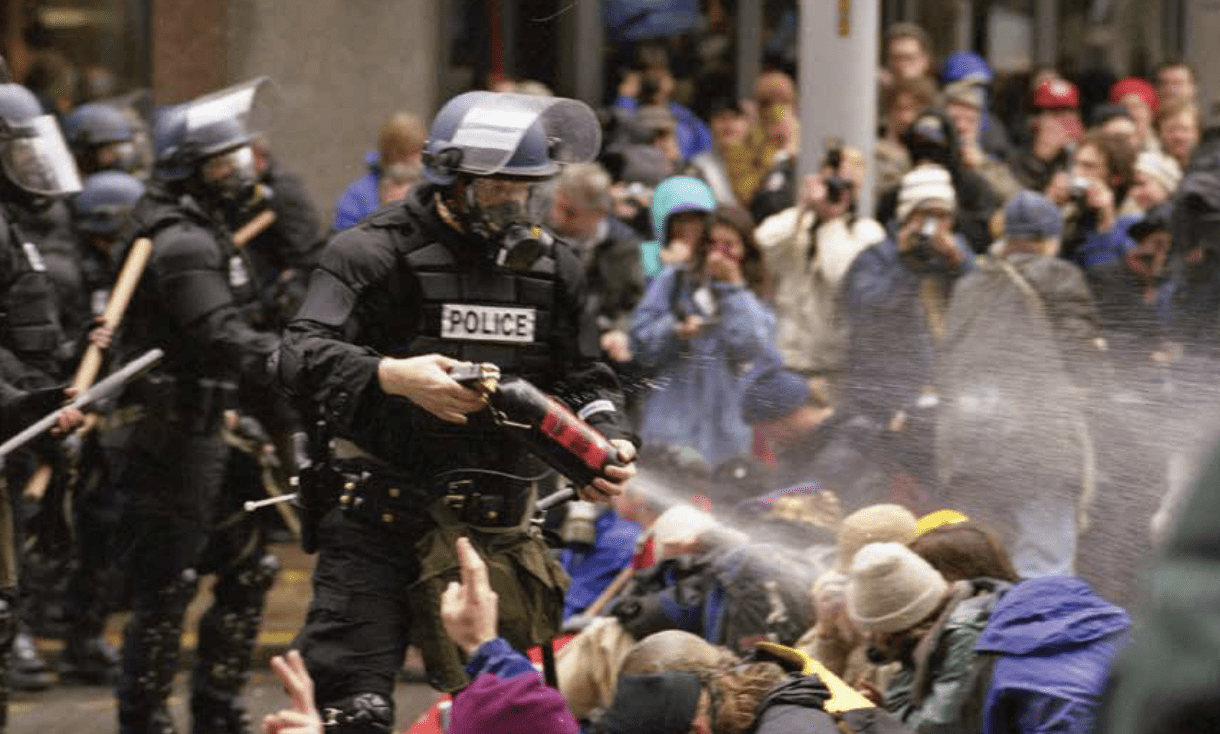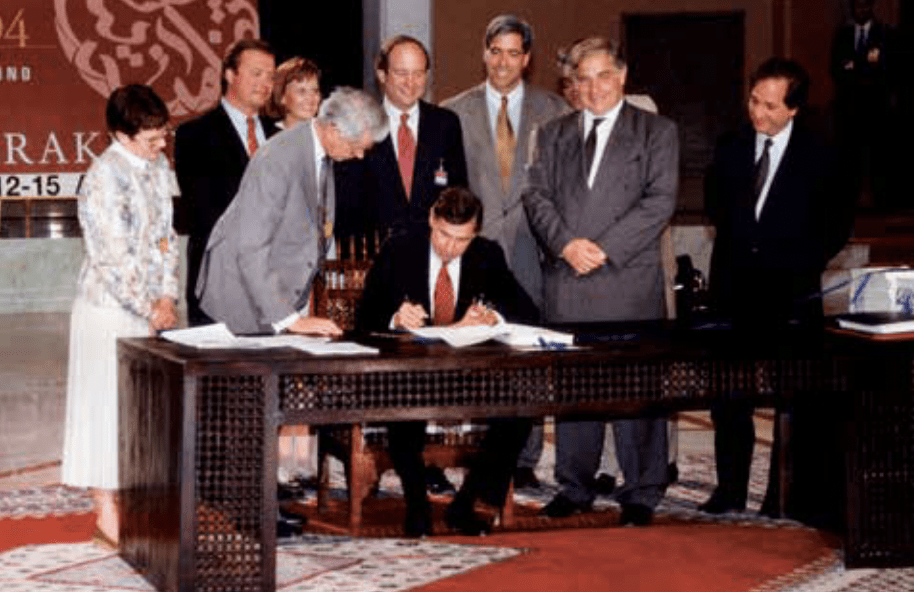How the World Trade Organization Became a Proxy Battleground
 The WTO’s ‘Battle of Seattle’ in November, 1999/Steve Kaiser
The WTO’s ‘Battle of Seattle’ in November, 1999/Steve Kaiser
The events of September 11, 2001 ushered in a new millennium with an emotional shock shared by humanity in real time. As the impact monopolized policy agendas for years, it overshadowed less spectacular transformations unleashed around the hinge of history of 2000, including the fourth industrial revolution, China’s rise and the disruption of global trade diplomacy. Policy Associate Editor Lisa Van Dusen explores the World Trade Organization’s bumpy ride since the Battle of Seattle.
Lisa Van Dusen
August 27, 2022
The existing global trade regime was born in 1947 with the General Agreement on Tariffs and Trade (GATT) and solidified in 1995 with the launch of its successor, the World Trade Organization (WTO). As it happened, two later events that straddled the birth of the millennium — the Seattle WTO Ministerial Conference of 1999 and China’s accession to the organization in December of 2001 — telegraphed the core elements of the drama that has defined the existential trajectory of the Geneva-based global trade arbiter in the two decades since: tactical intractability and China’s role in that tactical intractability.
When the “Battle of Seattle” began brewing in the streets of the host dateline days before the November 30, 1999 WTO ministerial, the metaphorical hordes of international trade bureaucrats, diplomats, negotiators and ministers preparing to descend on the Emerald City had to confront for the first time the prospect of a meeting derailed by actual hordes ostensibly so hostile to globalization and the WTO that a curfew was decreed amid “some of the tightest restrictions imposed on any US city since World War II,” per the New York Times. “Anyone protesting in a designated 19-block area faced immediate arrest.” The WTO’s role as a lightning rod for anti-globalization fervour — much of it genuine and motivated by a push for equality and fairness — was born, and the Seattle Round was stillborn.
Four months later, in Washington, on March 8, 2000, then-President Bill Clinton delivered his closing argument to America’s foreign policy elite, Congress and the international community on the merits of China’s accession to the WTO. With a key congressional vote looming, the case was made in a speech at the Johns Hopkins School of Advanced International Studies on Embassy Row. “Membership in the WTO, of course, will not create a free society in China overnight or guarantee that China will play by global rules,” said Clinton, who had made China’s WTO accession a key part of his policy legacy, eight months before the election of his successor. “But over time, I believe it will move China faster and further in the right direction.” In November, 2001, at the WTO ministerial at the comfortably remote Doha Sheraton in Qatar, the doomed Doha Development Round was launched, along with the organization’s approval of China’s entry as a member.
The WTO serves three main functions: facilitating trade negotiations, monitoring compliance and arbitrating trade disputes. It is sometimes also defined by three main “pillars”: market access, domestic support and export competition. But the nous of the WTO’s mission is probably best captured in the language of the Marrakesh Agreement of April, 1994 that codified the transition, at the successful conclusion of the Uruguay Round, from GATT to the WTO. “The establishment of the World Trade Organization ushers in a new era of global economic cooperation, reflecting the widespread desire to operate in a fairer and more open multilateral trading system for the benefit and welfare of their peoples,” the declaration reads. “Ministers express their determination to resist protectionist pressures of all kinds. They believe that the trade liberalization and strengthened rules achieved in the Uruguay Round will lead to a progressively more open world trading environment.”
War-and-peace is for the show horses, trade diplomacy culture contends; the real, daily, granular bargaining over salmon and softwood lumber and aluminium tariffs is where the irritant rubber meets the resolution road.
That worldview, reflecting as it does a belief in the unifying power of multilateralism in general and trade liberalization in particular, seems far more Panglossian in retrospect than it did at the time. In that post-Cold War window of broad and reasonable assumptions about the inviolability of the liberal, rules-based international order that had prevailed, the WTO, among the multilateral institutions, represented the core values of liberalization and rules. It also represented the engine of what all the trade negotiators in all the trade negotiations I’ve ever covered consider the grinding gears that really move global diplomacy. War-and-peace is for the show horses, trade diplomacy culture contends; the real, daily, granular bargaining over salmon and softwood lumber and aluminium tariffs is where the irritant rubber meets the resolution road. Trade negotiations are about jobs and livelihoods and the interdependence, communication and commerce fed by the vast, multicolored container Legolands of the ports of Los Angeles and Rotterdam and Singapore. Entire lunches are spent on the swapping of combat stories from the great WTO banana wars of the 90s.
When countries are able to negotiate their commercial interests, including the transnational movement of goods and provision of services, in a mature, equable, face-value, mutually and collectively beneficial fashion, it tends to be a barometer of diplomacy and international relations at other levels and on other files. Which is why, in a century defined so far by assaults on the institutions of democracy and the existing international order, the WTO has spent 20 years buffeted by narrative warfare, internal and external, intended to undermine its role in that order. The state of global trade always presents symptoms of referred pain or peace from larger dynamics. In this new smaller, interconnected, eminently hackable — literally and figuratively — world, that fact has become an organizational vulnerability for the WTO.
 Happier Times: US Trade Representative Mickey Kantor signing the April, 1994 Marrakesh Agreement
Happier Times: US Trade Representative Mickey Kantor signing the April, 1994 Marrakesh Agreement
codifying the transition from GATT to the WTO. —Wikimedia Commons
As it turned out, accession would, over time, move China faster and farther in the wrong direction, unless you happen to consider Beijing’s indispensable role in the global decline of democracy over the past two decades the right direction. China, from its exponentially disruptive position as a WTO member, has also moved the organization itself in the wrong direction as defined by any rational observer — toward internal division, avoidable conflict, tactical obstruction and reputational degradation. Or, as the subhead to the Wall Street Journal piece, How China Swallowed the WTO by Jacob M. Schlesinger from November, 2017, put it: “The US helped create the group to smooth global commerce and integrate a rising China. Instead, it’s become a battleground for intense national rivalries.”
That fate of tactical organizational weakening has befallen other United Nations bodies over the same time period, as China’s economic rise has enabled it to deploy a combination of financial carrots and intimidation sticks within the previously flawed but functional institutions that represent the liberal, democracy-led status quo of multilateralism. As with the systematic degradation of the domestic pillars of democracy in key geopolitical targets such as the United States, Britain, Italy and Brazil, among others, the gradual corruption capture of international institutions has hewed to an operational paradigm.
As Kristine Lee reported in her April 2020 Politico piece, It’s Not Just the WHO: How China Is Moving on the Whole U.N.: “Beijing has moved expeditiously to impose its illiberal values on international organizations. Through a combination of deft coalition-building, strategically timed financial contributions and narrative-shaping efforts, Beijing has made progress in transforming the U.N. into a platform for its foreign policy agenda, including advancing China’s economic interests, stifling dissent and democracy, and hollowing out the rules-based order.”
Beyond its assaults on the WTO’s institutional integrity, China has also been seizing control of the infrastructure of global trade, having established ownership positions in more than 100 ports in 63 countries.
As Lee points out, Donald Trump’s vilification of the WTO — wrapped as it was in the misdirectional faux patriotism of a traitorous president claiming to defend US interests even as he did more to advance the anti-democracy agendas of China and Russia than their own leaders ever could — only served to compound the organization’s woes. Like Trump’s withdrawal from the World Health Organization (a decision later reversed by the Biden administration), his attacks on NATO and his contempt for the G7, the inclusion of the WTO on his institutional hit list was a feature of his presidency for new world order aspirants, not a bug. Per NATO’s own description of hybrid warfare, “A hybrid actor attempts to erode trust between the state institutions and the people,” a narrative tactic we can assume also applies to multi-state institutions based on its frequent and overwhelmingly obvious use by hybrid actors against multilateral institutions.
In normal-presidency developments, the Biden administration’s 2021 annual report from the United States Trade Representative on China’s WTO Compliance, published in February, focused on Beijing’s persistent veer in the wrong direction on its economic model. “China has not moved to embrace the market-oriented principles on which the WTO and its rules are based, despite the representations that it made when it joined 20 years ago,” said USTR Katherine Tai. “China has instead retained and expanded its state-led, non-market approach to the economy and trade. It is clear that in pursuing that approach, China’s policies and practices challenge the premise of the WTO’s rules and cause serious harm to workers and businesses around the world, particularly in industries targeted by China’s industrial plans.”
Beyond its assaults on the WTO’s institutional integrity, China has also been seizing control of the infrastructure of global trade, having established ownership positions in more than 100 ports in 63 countries, including Los Angeles, Rotterdam and Singapore. The recent elevation of previously humming supply chains to the status of multifarious disaster rationale attests to the strategic value of those investments.
Among the more dubious hybrid warfare innovations of the political, geopolitical and propaganda revolution enabled by the internet is the weaponized abrogation of good faith. It makes negotiations of any consequence extraordinarily difficult because that’s what it is meant to do. Replacing the WTO with a new and different arbiter of global trade will only serve interests who see value in undermining status quo institutions to erect wholly Potemkin versions that better suit their purposes which, so far, have not redounded to the benefit of humanity.
Meanwhile, Canada has taken a leadership role on addressing what ails the World Trade Organization since the 14-country Ottawa Group on WTO reform was created in 2018. Perhaps, irony averted, its work will proceed unimpeded.
Policy Magazine Associate Editor and Deputy Publisher Lisa Van Dusen was a senior writer at Maclean’s, Washington columnist for the Ottawa Citizen and Sun Media, international writer for Peter Jennings at ABC News and an editor at AP National in New York and UPI in Washington. She has covered international trade as a writer and editor since the Montreal Midterm Ministerial of the final GATT Uruguay Round.
